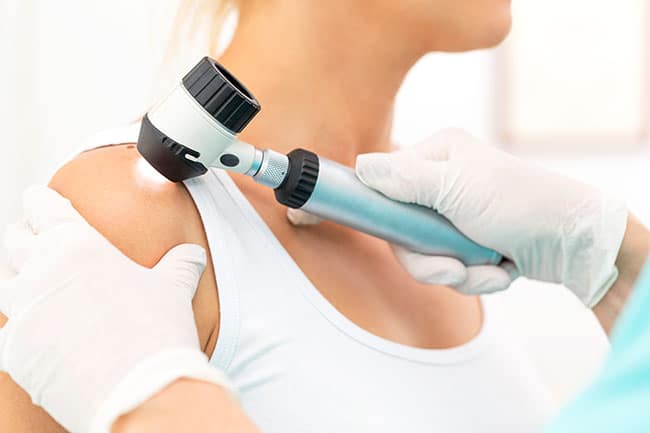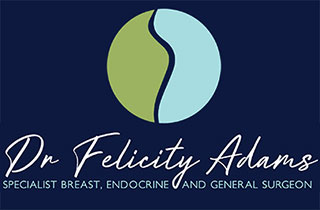Understanding Skin Cancer and Surgery treatments
Skin cancer is unfortunately very common in Australia, and Dr. Felicity Adams frequently performs surgery to remove various types of skin cancers, including Melanoma, Squamous Cell Carcinoma (SCC), and Basal Cell Carcinoma (BCC), from both the body and face. Dr. Adams has extensive experience in the surgical removal of skin cancers, providing careful and precise care to minimize scarring and ensure optimal outcomes.
In cases where melanoma is diagnosed, Dr. Adams is skilled in performing sentinel lymph node biopsy when indicated, a crucial procedure to assess the spread of cancer. Dr. Adams’ expertise in melanoma surgery is supported by her training tenure in the Melanoma Unit at the PA Hospital during her surgical training, further enhancing her ability to provide comprehensive care for melanoma patients.
With Dr. Adams and her dedicated team, you will receive the highest standard of care. Dr. Adams offers a complete in-house support team including a Wound Care Nurse. Our team provides specialized wound care to support healing and minimize scarring after surgery. With expert attention to wound management, we ensure that each patient receives the highest level of care for the best possible outcome.

Surgical Procedures for Skin Cancer Removal and Reconstruction
Where possible after removal of a skin cancer the wound is simply stitched back together – this is called primary closure. Sometimes primary closure is not possible or desirable. This can be because the defect or hole left by the excision is too large and the surrounding skin doesn’t have enough stretch.
Alternatively, on the face sometimes primary closure can result in alteration of facial features such as the eyes, nose and mouth, causing asymmetry and a poor cosmetic result. In these circumstances a skin flap or skin graft may be recommended.
A skin graft involves removing skin from one area of your body and moving it to another part of your body. The donor skin can be either split thickness or full thickness. Split thickness skin grafts can be used for large areas as well as small ones. The skin is thin and takes on a blood supply from the underlying tissue.
They are generally reliable though pre-existing infections, other patient health problems or a location below the knee can make their “take” or healing more difficult. The donor skin is often taken from the upper thigh and an open wound is left here and not stitched but covered with a dressing and allowed to heal.
Full thickness skin grafts are often used on the face. Donor skin is matched as well as possible for colour and texture. It can be taken from many areas where there is loose skin (such as the neck, arm, above the collar bone, in front or behind the ear) and a straight surgical wound is left here.
All skin grafts leave a patch type look though with an alteration in the colour or contour of the area long term. Sometimes this can be barely noticeable, other times it is more so.
Scarring
it is impossible to do surgery without scarring. Some people form nice pale scars and others thick pink scars. Scarring is largely dependent on the patient’s own skin rather than surgical factors. The length of the scar is considerably longer than the abnormality to be excised. If you are concerned about scarring please discuss this with Dr Adams prior to your surgery.
Skin cancer surgery is overall low risk but sometimes problems can occur.
Bleeding / Bruising
is usually minor and can be stopped with pressure and elevation of the body area. When the bleeding involves a flap or graft it can affect its success.
Infection
again is not life threatening and can be treated easily with antibiotics. It can threaten the success of flaps and grafts and prolong the healing time for all types of wounds.
Scarring
it is impossible to do surgery without scarring. Some people form nice pale scars and others thick pink scars. Scarring is largely dependent on the patient’s own skin rather than surgical factors. The length of the scar is considerably longer than the abnormality to be excised. If you are concerned about scarring please discuss this with Dr Adams prior to your surgery.
Wound Breakdown
is relatively uncommon after a simple excision. The risk is increased with wound infection and also in areas where the skin moves a lot with body movement such as the back or near joints.
Prolonged wound healing
can sometimes occur with skin grafts if they don’t completely “take” or become incorporated into their new location by developing a blood supply. Wounds below the knee is a risk for these because of the areas reduced blood supply and/or drainage. Diabetes, immune suppression medications, previous radiotherapy and infection are other risk factors for this.
Nerve Damage
tiny sensory nerves in the skin are commonly damaged with skin cancer removal. This can result in an area of numbness, which does improve over time but may never return to normal. Damage to nerves controlling movement is very rare but can occasionally occur with cancers on the face or with deep excisions such as for melanoma.
It is best to not plan to be away for long periods after your surgery such that Dr Adams can see you to remove stiches (if applicable), provide wound care and discuss the results of your microscope test. If you have a trip planned please discuss this with Dr Adams at your initial consult.

